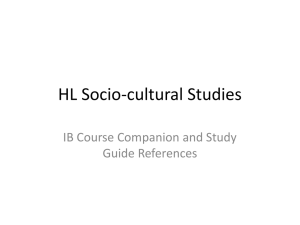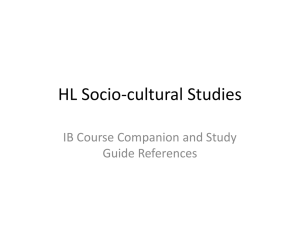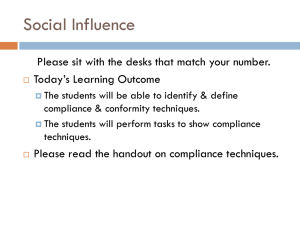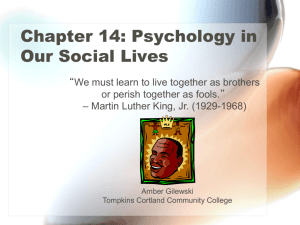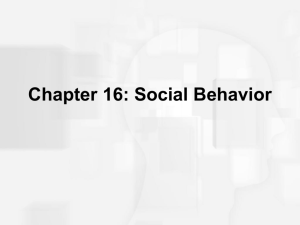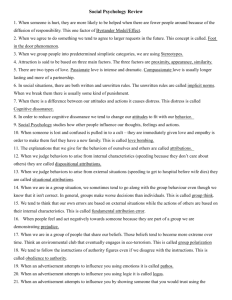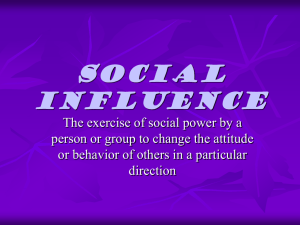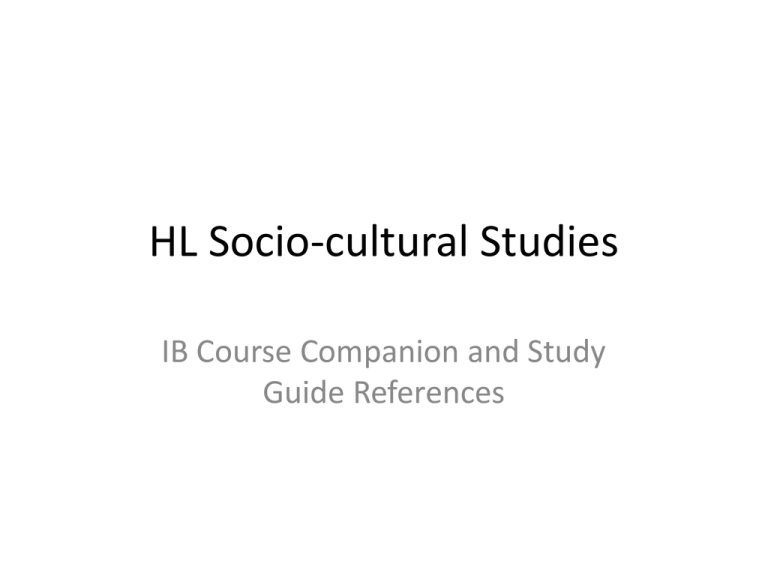
HL Socio-cultural Studies
IB Course Companion and Study
Guide References
Festinger et al (1956)
• Festinger and his team covertly observed a
religious cult in Chicago that believed the world
would end on December 21st and that they would
be rescued by flying saucers if they followed the
rituals and texts. When the prophesy did not
take place, the cult decided that God had not
destroyed the world because of their prayers.
• http://en.wikipedia.org/wiki/When_Prophecy_Fa
ils
•
Attributions in the sports pages.
By Lau, Richard R.; Russell, Dan
Journal of Personality and Social Psychology, Vol 39(1),
Jul 1980, 29-38
Abstract
• Extended the generality of attribution research by exploring several
important issues in a highly involving real-world setting in which
attributions naturally occur: athletic competition. 107 newspaper
accounts of baseball and football games were coded for attributional
content. These data support a motivational or self-enhancement
explanation for the tendency to make internal attributions (talent or
hardwork) for success and external attributions (injuries or bad weather)
for failure. No support was found for D. T. Miller and M. Ross's (1975)
contention that this tendency is mediated by expectancies. It was also
found that more attributions were made after unexpected, as opposed to
expected, outcomes. There was a tendency for relatively more stable
attributions to be given after expected outcomes. The advantages and
disadvantages of studying attributions in archival data and the possibility
of attributions justifying rather than explaining behavior are discussed. (25
ref) (PsycINFO Database Record (c) 2012 APA, all rights reserved)
•
http://psycnet.apa.org/index.cfm?fa=buy.optionToBuy&id=1981-23644-001
Greenberg et al. (1982)
• Self serving bias protects self esteem.
– It boosts our self-esteem to attribute our
successes to dispositional factors.
– It boosts our self-esteem to attribute our failures
to situational factors.
Self-serving biases in the attribution of causality: Fact or fiction?
Miller, Dale T.; Ross, Michael
Psychological Bulletin, Vol 82(2), Mar 1975, 213-225.
• If we expect to succeed, and we do, we attribute it to our skill and ability.
If we expect to succeed and do not, then we feel it is bad luck or external
factors.
• A review of the evidence for and against the proposition that self-serving
biases affect attributions of causality indicates that there is little empirical
support for the proposition in its most general form. Some support was
found for the contention that individuals engage in self-enhancing
attributions under conditions of success, but only minimal evidence
suggested that individuals engage in self-protective attributions under
conditions of failure. Moreover, it was proposed that the self-enhancing
effect may not be due to motivational distortion, but rather to the
tendency of people to (a) expect their behavior to produce success, (b)
discern a closer covariation between behavior and outcomes in the case of
increasing success than in the case of constant failure, and (c) misconstrue
the meaning of contingency. (60 ref) (PsycINFO Database Record (c) 2012
APA, all rights reserved)
Kashima and Triandis (1986)
• US and Japanese students
• Asked participants to remember details of
slides of scenes from unfamiliar countries
• When asked to explain their performance,
Americans tended to attribute success to
ability and failure to external factors—SSB
while the Japanese tended to explain their
failures in terms of their lack of ability—
modesty bias.
Bond, Leung, and Wan (1982)
Chinese students who exhibited the modesty
bias instead of the SSB were more popular
with their peers.
. One possible explanation for this link is that
modest behavior can help to deflect attention
from ways in which individuals stand out from
their group, thus promoting harmonious
interpersonal relations within collectivist
societies (see also Bond et al., 1982).
Tajfel’s Social Identity Theory
• Social categorization
• In-group, out-group
• Social comparison—benefits of belonging to
in-group versus out-group
• Sherrif—Robbers Cave study and Tajfel—Klee
and Kandinsky and dots studies
http://www.spring.org.uk/2007/11/why-groupsand-prejudices-form-so.php
Cialdini, R. B., et al. (1976). Basking in reflected glory: Three (football) field
studies. Journal of Personality and Social Psychology, 34, 366-375.
•
•
The idea of associating oneself with successful others was described by Cialdini and his co-authors
as a relatively "true to life" theoretical phenomenon without much empirical support. In this classic
article, the tendency to "bask in reflected glory (BIRG)" or associate oneself publicly with successful
others was investigated by using a series of experiments with football fans from large prestigious
football schools (e.g., Ohio State, Michigan, and Notre Dame). In an attempt to demonstrate
BIRGing, the researchers conducted a field experiment (in large lecture halls across 7 different
schools) where they observed student clothing/apparel on a Monday following a big football game.
The researchers found that students tended to wear more apparel associating themselves with
their own university (e.g., jersey or sweatshirt) when the football team won compared to when
they lost. Based on these findings, the researchers sought to further understanding BIRGing effects
and did so by randomly calling students and interviewing them about the performance of their
schools football team following a game.
The researchers found that people tended to use the pronoun "we" more to describe their team
when they won and "they" more when the team had lost. In some of these experiments, the
researchers manipulated the feelings of the participants by employing distraction tasks and giving
positive/negative feedback. By way of this manipulation, the researchers were able to show that
people tend to associate with positive others most closely when their own public image is
threatened. This article is classic because it clearly demonstrated that people associate themselves
with positive others even when they have no clear connection to the success of the positive others,
which is essentially the BIRG phenomenon.
Moscovici (1973)
• Social representations—shared beliefs and
explanations held by the society in which we
live or the group to which we belong—are the
foundation of social cognition, helps us to
make sense of and master the world, enable
communication of community by providing a
social exchange and naming/classifying code
• Fundamental cultural schemas
'So, you're from Brixton?': the struggle for recognition and esteem in a multicultural
community
Howarth, Caroline (2002) 'So, you're from Brixton?': the struggle for recognition and
esteem in a multicultural community. Ethnicities, 2 (2). pp. 237-260. ISSN 1468-7968
•
•
•
Focus group interviews
The first section illustrates how identity is constructed through and against the
representations held by others within particular social contexts. Focusing on the
varying strategies that different young people adopt in constructing a positive
identity reveals the salience of racist representations in the social construction of
Brixton. The second section examines the effects this can have on the self-image
and self-esteem of many in the study, looking in particular at strategies used to
contest negative versions of blackness. This points to the racializing and gendering
within the (re)production of local youth identities. The concluding section
illustrates how some young people collaboratively develop the social and
psychological resources to protect themselves against the prejudices of others.
Together, this material reveals how social relationships and institutional cultures
empower/disempower Brixton's youth in their collaborative struggle for
recognition and esteem. This allows us to consider how new multicultures address,
incorporate and resist new racisms and prejudices towards a locality.
http://eprints.lse.ac.uk/2435/
Jane Elliott
• videos
Stereotype Threat—Steele and
Aronson 1990s
• http://en.wikipedia.org/wiki/Stereotype_thre
at
Spotlight anxiety causes emotional distress and
pressure that may undermine performance.
STEREOTYPES AND THE PERCEPTION OF GROUP DIFFERENCES.
CAMPBELL, DONALD T.
American Psychologist, Vol 22(10), Oct 1967, 817-829.
• EMPHASIZES "THE WAY IN WHICH BOTH ANTHROPOLOGICAL EVIDENCE
AND LEARNING THEORY PREDICT THAT IF THERE ARE GROUP DIFFERENCES
OR DIFFERENTIALS IN SOCIAL INTERACTION, THESE WILL TEND TO APPEAR
IN THE STEREOTYPES GROUPS HAVE OF EACH OTHER." (PsycINFO Database
Record (c) 2012 APA, all rights reserved)
• Sources of stereotypes: personal experience with individuals and groups
and gatekeepers—media, parents, and other members of our culture.
• Grain of truth hypothesis: an experience with an individual from a group
will then be generalized to the group
Hamilton and Gifford (1976)
• Stereotypes are the result of an illusory
correlation—people see a relationship
between two variables even when there is
none. Illusory correlation cognitive bias
(relationship between two variables when
there is none)confirmation bias (seek or
remember information)
• http://en.wikipedia.org/wiki/Illusory_correlati
on
Snyder and Swann (1978)
• Confirmation bias study
• http://homepage.psy.utexas.edu/HomePage/Fac
ulty/Swann/publications.htm
• Female college students told that they would
meet an introverted or extroverted person and
then asked to prepare questions.
• Participants came up with questions that
confirmed their perceptions, for example, what
do you dislike about parties or are there times
you wish you could be more outgoing or what do
you do to liven up a party.
Bandura’s social learning theory
• Learn norms via observational learning
• Includes attention, retention, motor
reproduction, and motivation
• Imitation and learning influences: consistency
of model, identification with model, rewards
and punishment—vicarious reinforcement,
liking the model
Imitation of nurturant and nonnurturant models.
Yarrow, Marian R.; Scott, Phyllis M.
Journal of Personality and Social Psychology, Vol 23(2), Aug 1972,
259-270.
• Investigated influences of the model-child relationship on the
child's imitation in a laboratory setting. 118 preschool children were
in small play groups under the supervision of either a nurturant or a
nonnurturant caretaker. 2 female adults carried out both roles with
different groups. In these contrasting contexts, the models
performed standard responses incidentally during group play; other
responses were performed in a play task, with Ss' attention directed
to the model. Model nurturance and nonnurturance (a) had no
effect on gross frequency of imitation; (b) had an influence on the
content of imitated acts (nurturance was emphasized under
nurturant models; nonnurturance, under nonnurturant models);
and (c) were related to frequency of delayed and generalized
imitation. Both nurturance and nonnurturance were significantly
greater with nurturant models. (PsycINFO Database Record (c) 2012
APA, all rights reserved)
Bandura and Ross (1961)
• http://www.simplypsychology.org/bobodoll.html
Longitudinal relations between children's exposure to TV violence and their
aggressive and violent behavior in young adulthood: 1977-1992.
Huesmann, L. Rowell; Moise-Titus, Jessica; Podolski, Cheryl-Lynn; Eron,
Leonard D.
Developmental Psychology, Vol 39(2), Mar 2003, 201-221.
• Although the relation between TV-violence viewing and aggression
in childhood has been clearly demonstrated, only a few studies
have examined this relation from childhood to adulthood, and
these studies of children growing up in the 1960s reported
significant relations only for boys. The current study examines the
longitudinal relations between TV-violence viewing at ages 6 to 10
and adult aggressive behavior about 15 years later for a sample
growing up in the 1970s and 1980s. Follow-up archival data (N=450)
and interview data (N=329) reveal that childhood exposure to
media violence predicts young adult aggressive behavior for both
males and females. Identification with aggressive TV characters and
perceived realism of TV violence also predict later aggression. These
relations persist even when the effects of socioeconomic status,
intellectual ability, and a variety of parenting factors are controlled.
(PsycINFO Database Record (c) 2013 APA, all rights reserved)
Kimball and Zabrack (1986)
• http://books.google.com/books?id=kUxCx79K
pUAC&pg=PA30&lpg=PA30&dq=kimball+zabra
ck+1986+canada&source=bl&ots=UB_XSSXCB&sig=h2u545uSu3tkv1Yo6pLxCa6aXY&hl=en&sa=X&ei=V
mfwUquSF4qy2QXW4ID4AQ&ved=0CFAQ6AE
wBQ#v=onepage&q=zabrack&f=false
Charlton, Gunter, and Hannan (2002)
• http://www.questia.com/library/104941544/bro
adcast-television-effects-in-a-remote-community
• On St Helena island television was introduced in
1995, so cameras were set up in playgrounds of
two primary schools and behavior of children
aged 3-8 was observed before and after TV
introduction (natural experiment). Experimenters
also interviewed teachers, parents, and some
older children. There was no increase in
aggressive or antisocial behavior—5 years later,
too.
Compliance techniques—result of
direct pressure (Cialdini)
• Authority
• Commitment
• Liking
• Reciprocity
Lynn and McCall (1998)—Mint increases tip; Cialdini et al. (1975) door-in-theface technique:
http://faculty.babson.edu/krollag/org_site/soc_psych/cialdini_door_face.
html; Dickerson et al. (1992) foot-in-the-door technique: university
students to conserve water in dorm showers, first asked to sign a poster,
then asked to do a survey about own water usage, then shower time was
monitored; students who had signed the poster and completed the survey
spent on average 3.5 minutes less in the shower
• Scarcity
• Social proof
http://www.youtube.com/watch?v=cFdCzN7RYbw
Conformity
• Sherif’s conformity to the perceived group
norm (1936) and Asch’s conformity to the
majority (1951):
• http://www.simplypsychology.org/conformity.
html and
http://www.simplypsychology.org/aschconformity.html
Moscovici and Lage (1976)
• Blue Green Study and minority influence:
http://www.simplypsychology.org/minorityinfluence.html
As opposed to groupthink in which group
members have a unanimous opinion on an
issue and do not seek out alternative or
dissenting opinions
Why conform?
• Deutsch and Gerard (1955)—informational
social influence and normative social influence
• Festinger (1954)—social comparison—what
others do and cognitive dissonance
Counter conformity studies
•
Bond and Smith (1990s) meta-analysis of conformity studies using
an Asch-type line judgment task (1952b, 1956) was conducted to
investigate whether the level of conformity has changed over time
and whether it is related cross-culturally to individualismcollectivism. The literature search produced 133 studies drawn from
17 countries. An analysis of U.S. studies found that conformity has
declined since the 1950s. Results from 3 surveys were used to
assess a country's individualism-collectivism, and for each survey
the measures were found to be significantly related to conformity.
Collectivist countries tended to show higher levels of conformity
than individualist countries. Conformity research must attend more
to cultural variables and to their role in the processes involved in
social influence.
• http://www.radford.edu/~jaspelme/_private/gradsoc_articles/indiv
idualism_collectivism/conformity%20and%20culture.pdf
Berry (1967)
• Temne people of Sierra Leone conformed
significantly more than the Inuit people of
Canada. He explained this in terms of
differences in economic practices—Temne
single crop and therefore
community/consensus/agreement reliance
and Inuit continual hunting and gathering on
an individual basis.
Defining Culture
• References a book that analyzed 128 definitions of culture,
“a dynamic system of rules, explicit and implicit,
established by groups in order to ensure their survival,
involving attitudes, values, beliefs, norms, and behaviors”
(Matsumoto, 2004)
• Surface culture
• Deep culture—beliefs, attitudes, and values (Kuschel, 2004)
• Common rules that regulate interactions and behavior in a
group, as well as shared values and attitudes (Lonner, 1995)
• Mental software—internalized cultural schemas that
influence thinking, emotions, and behavior i.e. collective
mental programming (Hofstede, 2002)
• Etic (universal) vs. emic (culturally specific)
Hofstede (1973)
• 88, 0000, multinational IBM company employee
surveys about morale in the workplacetrends
from the 40 most represented countries in the
surveysculture is a collective phenomenon
distinguished by dimensions
• Culture as mental programming or mental
software
• http://en.wikipedia.org/wiki/Hofstede's_cultural
_dimensions_theory
• Confucian work dynamism: instead of focusing
on truth, some cultures focus on virtue (Bond,
1988)
• China and other Asian countries—long-term
orientation—value persistence, loyalty, and
trustworthiness
• Finland, France, Germany, and the US have a
short-term orientation (Hofstede).
Mead (1935)
• New Guinea observations
• http://www.loc.gov/exhibits/mead/fieldsepik.html

